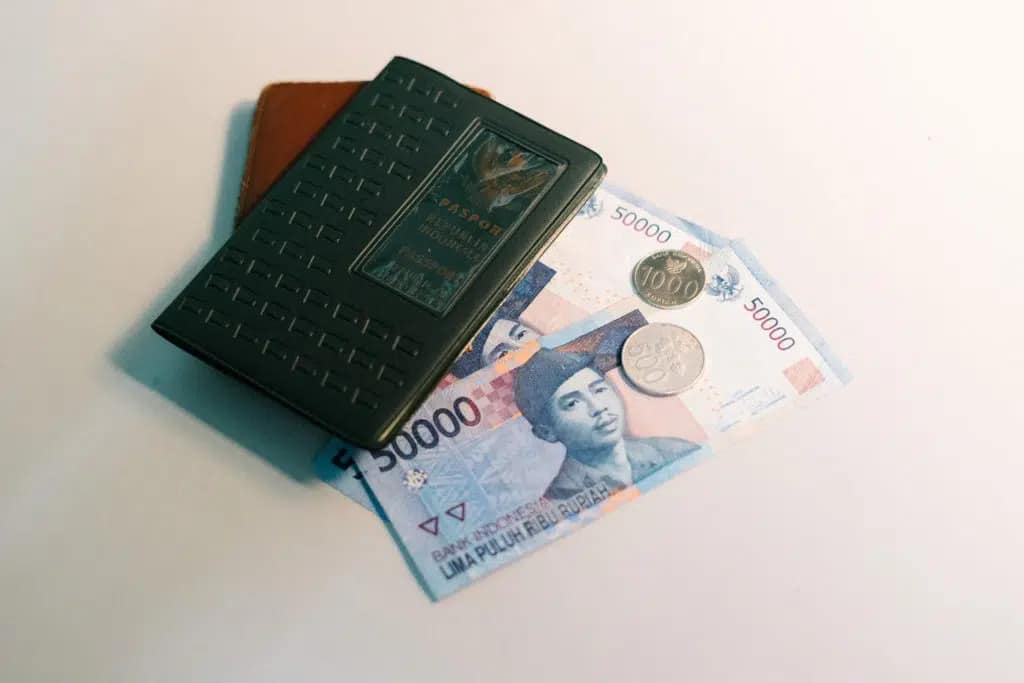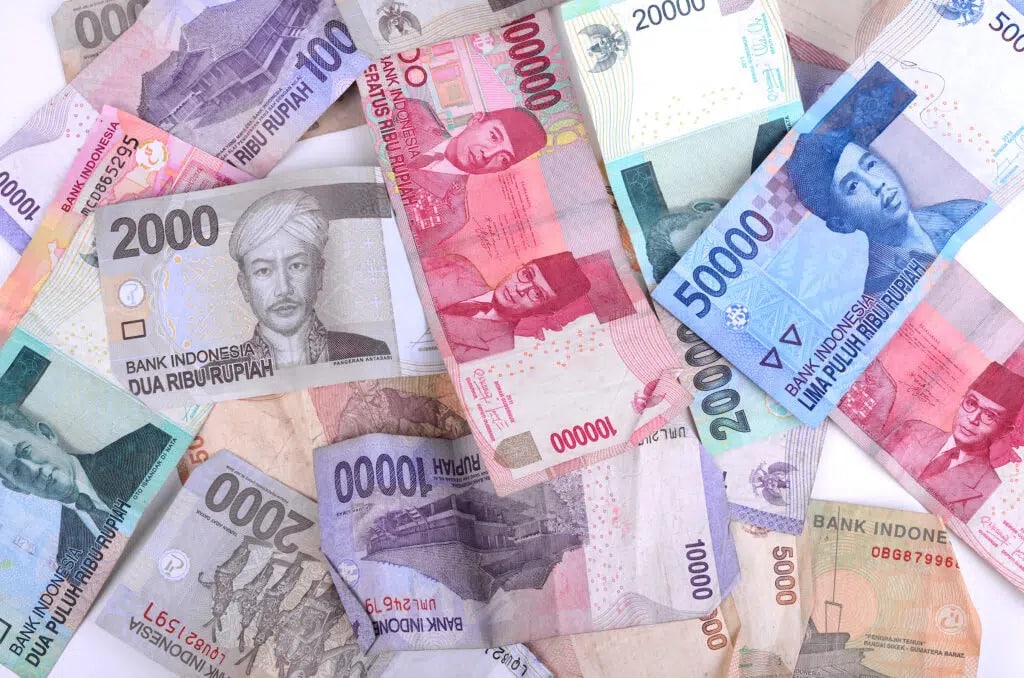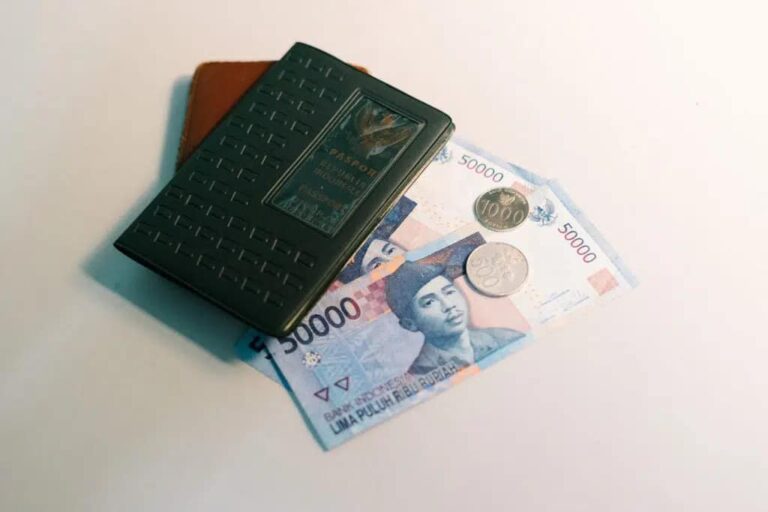
Are you planning on traveling to Indonesia, or do you want to send money home? If so, you’ll need to exchange your USD, CAD, AUD, BHD, GBP, or other currency for Indonesian rupiah.
Keep reading this Remitly guide to learn about the denominations of the rupiah and some lesser-known facts to help you understand Indonesia’s currency.
What is the name for Indonesian money?
The name for legal tender in Indonesia is the Indonesian rupiah. The currency code for Indonesia currency is IDR. However, when you’re in Indonesia, you’ll see the currency symbol Rp used instead of IDR. Normally, the symbol appears directly before a price, such as Rp20,000.
A part of the Indonesian government, the Central Bank of Indonesia issues the rupiah, which has been the sole recognized currency of Indonesia since the 1950s. The national bank also has the power to set short-term interest rates, impacting prices for goods and services and contributing to the overall Indonesian economy.
Rupiah banknotes and coins: A closer look at Indonesia’s money
In Indonesia, both paper notes and coins are in circulation. Let’s take a quick look at the denominations available for both coins and paper bills.
Indonesian rupiah banknotes
Rupiah bills are distinguishable not only by their numerical value but also by their size and color. Indonesian rupiah banknotes include:
- 1,000 Indonesian rupiah note
- 2,000 Indonesian rupiah note
- 5,000 Indonesian rupiah note
- 10,000 Indonesian rupiah note
- 50,000 Indonesian rupiah note
- 75,000 Indonesian rupiah note (issued in 2020)
- 100,000 Indonesian rupiah note
We’ll discuss what the various IDR banknotes look like a little later on in this guide.
Though 100,000 rupiahs might sound like a lot, the currency isn’t especially strong when compared to the U.S. dollar; 1 Indonesian rupiah isn’t worth much as compared to other currencies.
Over a five-year period from 2019 to 2023, 100,000 Indonesian rupiahs have been worth between $6 and $8 USD. Even so, most Indonesians, especially vendors, consider the 100,000 rupiah note inconvenient and too large for everyday use.
Indonesian rupiah coins
Rupiah coins are also available. They come in denominations of:
- 25 Indonesian rupiahs
- 50 Indonesian rupiahs
- 100 Indonesian rupiahs
- 200 Indonesian rupiahs
- 500 Indonesian rupiahs
- 1,000 Indonesian rupiahs
Due to the currency’s value compared to foreign currency, there are no 1 IDR coins. Currency exchange rates fluctuate constantly, but in the early 2020s, 1,000 IDR has been worth far less than 1 USD — usually only a few cents. The Rp1,000 bill is mainly used as change and has largely been replaced by coinage.
2,000 IDR is a typical parking fee, and 5,000 IDR can get you a bottle of water at a market.

A brief history of the Indonesian rupiah
The term “rupiah” comes from the Sanskrit word rupyakam, which translates to silver. (Other currencies, like the Indian rupee (INR) or the Nepalese rupee (NPR), also derive their names from this word.) Many Indonesians call the rupiah “Perak,” which means silver in Indonesian.
The rupiah was first issued in October 1946 and replaced the Indonesian Dutch East Indies guilder. (The country was a colony of the Netherlands until World War II.)
From the late 1940s to the early 1950s, two currencies were circulating on the island of Java. These included florins, used in areas controlled by the Dutch, and rupiahs, used in Indonesian enclaves. By January 1947, 310 million rupiahs had already been printed.
It wasn’t until 1950 that the IDR became the official currency of Indonesia after the Dutch recognized the country’s independence.
During the 1950s, Indonesia’s currency depreciated, so a new rupiah was issued in 1965. The exchange rate was 1,000 old rupiah for 1 new rupiah. By 1970, inflation had fallen, and exports grew.
Over the years, many attempts were made to stabilize the Indonesian rupiah, moving from fixed exchange rates to a managed float and then to a free-floating system following the Asian financial crisis. Since 1999, the rupiah has been relatively stable, even though it has been under pressure several times, particularly during the financial crisis of 2007-2008.

5 interesting facts about the Indonesian rupiah
In addition to having a rich history, the Indonesian rupiah has some unique characteristics. Let’s take a look at some intriguing facts about the currency.
1. Rupiah bills can be very colorful, with the less colorful banknotes being less valuable.
You’ll find Indonesia’s currency quite vibrant if you’re used to American or European currency.
For example, the 20,000 IDR banknote is light green, while the 50,000 IDR banknote is bright blue. The 100,000 IDR note is red.
The two smallest bills, 1,000 IDR and 2,000 IDR, are less vivid. The 1,000 IDR note is yellow-gray, and the 2,000 IDR note is gray.
2. Rainbows, stripes, and gold: Rupiah banknotes have fancy security features.
Much like the banknotes of other nations, money in Indonesia features several security measures. These include electrotypes, watermarks, security threads, metameric windows (clear windows), holograms, tactile features, gold patches, and iridescent stripes.
In 2010 and 2011, the central bank revised the rupiah banknotes and added new security features. These included rainbow printing that changes the color of the note when viewed from different angles.
The banknotes also have EURion constellation rings (a pattern of symbols) to prevent counterfeiting. For those who are blind or visually impaired, there are blind codes along the edges of the banknotes for easier identification of different denominations.
3. The 75,000 IDR bill celebrates 75 years of independence.
Although rarely used, Indonesia’s central bank issued the red and white 75,000 IDR note to celebrate the country’s independence. Its release was an expression of gratitude as well as a symbol of optimism.
This most recent addition to IDR designs showcases the faces of the country’s first president and vice president, Soekarno and Muhammad Hatta, respectively.
The Bank of Indonesia released 75 million pieces of the limited 75,000 IDR bill. It also released commemorative bills to celebrate Indonesia’s 25th, 45th, and 50th anniversaries.
4. Indonesian banknotes have changed over time.
As the value of the Indonesian rupiah changed over the years, so did the designs of the currency. In the previous series, the bills featured national heroes and a cultural scene or landmark.
For example, on the 5,000 IDR bill (issued in 2001), Tuanku Imam Bondjol was proudly displayed, as he was one of the most popular leaders of the Padri movement and a national hero. On the reverse side was an image of women weaving.
The 20,000 IDR bill (issued in 2004) featured Oto Iskandar Di Nata, an Indonesian politician and national hero who was assassinated in 1945. On the other side were tea pickers.
The most recent series, issued in 2016, excluding the 75,000 IDR bill, features national heroes once again.
However, the reverse side now highlights popular sites and famous dances. For example, on the Rp 5,000 bill, you’ll find Idham Chalid (an Indonesian politician, minister, and religious leader). The reverse side displays the Gambyong dance, Mount Bromo, and tuberose flowers.
5. Transactions in Indonesian currency commonly run into the millions.
Due to inflation, transactions in Indonesian rupiahs come with numerous zeros. To put this into perspective, look at the cost of living in Indonesia.
In 2022, a loaf of bread can cost over Rp15,000, a mid-range bottle of wine is around Rp300,000, one month of childcare is over Rp1.4 million, and rent for a one-bedroom apartment outside the city center is over Rp2.4 million.
As a result, consumers need to carry a large amount of cash to pay for daily transactions. This is similar to how prices tend to be large in some other world currencies, such as the yen in Japan and the rupee in India.

Understanding Indonesian Rupiah Exchange Rates
Whether you’re visiting Indonesia or sending money to loved ones there, you’ll want to check the currency exchange rate. This rate will determine how many rupiahs you will get for each unit of currency you exchange.
In addition to the USD rate, other popular currencies to compare against the IDR include:
- Chinese renminbi (CNY and CNH)
- Japanese yen (JPY)
- Malaysian ringgit (MYR)
- Thai baht (THB)
- Pakistani rupee (PKR)
- South African rand (ZAR)
- Singapore dollar (SGD)
- New Zealand dollar (NZD)
- Australian dollar (AUD)
- Canadian dollar (CAD)
- British pound (GBP)
- Euro (EUR)
A quick search with an online currency converter will help you determine the real-time rupiah exchange rate. A money transfer app like Remitly will also show you the current rate for IDR when you log in.
How to calculate USD dollar to Indonesian rupiah (USD to IDR) transactions
Let’s take a look at how to calculate dollars to IDR with a real exchange rate. At the time of writing, the exchange rate for USD to IDR was 1 USD = 15560.75 IDR.
Imagine you wanted to send 100 USD to a loved one in Indonesia. To determine how much they would receive, you would use the following equation:
100 USD x 15560.75 = 1,556,075 IDR
Once you’ve used the equation to convert USD to IDR, you need to subtract any fees. The economy fee for sending 100 USD to IDR is $3.99. Now, let’s convert that to IDR.
3.99 USD x 15560.75 = 62,087 IDR
Now, you subtract the fee from the total amount, leaving your loved one with 1,493,988 IDR.
How to enjoy huge savings when you exchange currency
Whether you’re sending money to Indonesia or converting a foreign currency like USD to IDR in person in Indonesia, you can save money by following these tips.
Shop around for the best exchange rate and fees online
If you want to fund a transfer to loved ones in Indonesia with US dollars or another currency, check out the fees and exchange rates on multiple providers. Also, be sure to look at other features, such as the speed of the transfers and the funding and receiving options, to find a provider that meets your needs.
Keep an eye on Indonesian currency rankings
Since the exchange rate varies based on the state of the Indonesian and global economy, keeping an eye on current rates can help you time transfers wisely.
When you see that the value of the IDR compared to a foreign currency like the US dollar is particularly low, it can be a great time to make a transfer, as your US dollars will go further.
Avoid airports when exchanging for Indonesian money
If you’re in Indonesia and need to change foreign currencies, skip the counters at the airports. Although airport desks make it simple to trade USD to IDR, they often have bad exchange rates and charge high fees.
Banks typically offer more favorable rates, and some hotels will also help you obtain local currency for fair prices.
Withdraw funds at ATMs
One of the simplest and most affordable ways to get IDR when you’re in Indonesia is to make a withdrawal from an ATM. Though you may be charged fees by both your financial institution and the Indonesian bank, the price is usually low.
Just make sure to let your bank know about your travel plans to avoid any problems making withdrawals in Indonesia.
Sending money to Indonesia
Now that you know about converting currencies like the US dollar to the Indonesian rupiah, you’re ready to start sending money to your loved ones, and Remitly can help.
